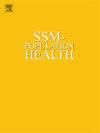Urban riverbank green spaces as therapeutic environments: Examining the psychosocial benefits of square dance in aging populations in China
IF 3.1
2区 医学
Q1 PUBLIC, ENVIRONMENTAL & OCCUPATIONAL HEALTH
引用次数: 0
Abstract
Green spaces along urban rivers have become popular venues for promoting physical activity (PA), particularly among older adults. However, there is little research on how the timing (morning versus nighttime) and location (green versus non-green spaces) of square dancing (reflecting PA) influence psychosocial benefits for older adults. Furthermore, gender differences in these interactions remain unexplored. This study examines the psychosocial benefits (e.g., reducing anxiety and depression disorders, improving psychological well-being and quality of life, enhancing emotional well-being, and alleviating psychological stress) of square dancing for aging Chinese adults with gender-specific preferences. This study utilized a cross-sectional sampling method with older adults from urban riverbank green spaces in China (N = 536; 315 women and 221 men) in 2023. We collected demographics, preferences (both time and location), and psychosocial health outcomes using well-known tools. Statistical analyses included correlation assessments, Wald Chi-Square tests, and gender-specific comparisons. Results indicated that 71.08 % of participants preferred PA in green spaces and 60.82 % preferred nighttime activities, highlighting clear patterns of engagement. Among men, PA timing was more strongly related to anxiety levels (Wald χ2 = 5.178). Conversely, PA location was significantly associated with emotional well-being (Wald χ2 = 5.822) and quality of life (Wald χ2 = 6.748) outcomes among women. Nighttime PA in urban riverside green spaces offers psychological benefits to older Chinese adults, highlighting distinct gender- and time-specific effects. Considering these findings, public health and community planning initiatives need to be customized to improve overall health and well-being among the aging population.
城市河岸绿地作为治疗环境:广场舞在中国老年人群中的社会心理效益研究
城市河流沿岸的绿地已成为促进身体活动(PA)的热门场所,尤其是在老年人中。然而,关于广场舞的时间(早上与晚上)和地点(绿色与非绿色空间)(反映PA)如何影响老年人的心理社会效益的研究很少。此外,这些相互作用中的性别差异仍未得到探索。本研究探讨了广场舞对具有性别偏好的中国老年人的心理社会效益(如减少焦虑和抑郁障碍、改善心理健康和生活质量、增强情绪健康和缓解心理压力)。本研究采用横断面抽样方法,对来自中国城市河岸绿地的老年人(N = 536;到2023年,女性为315人,男性为221人。我们使用众所周知的工具收集了人口统计数据、偏好(时间和地点)和心理健康结果。统计分析包括相关性评估、Wald卡方检验和性别比较。结果表明,71.08%的参与者更喜欢在绿地上的PA, 60.82%的参与者更喜欢夜间活动,突出了明确的参与模式。在男性中,PA时间与焦虑水平的相关性更强(Wald χ2 = 5.178)。相反,PA位置与女性的情绪幸福感(Wald χ2 = 5.822)和生活质量(Wald χ2 = 6.748)结果显著相关。城市滨江绿地的夜间PA为中国老年人提供了心理上的好处,突出了明显的性别和时间特异性效果。考虑到这些发现,需要定制公共卫生和社区规划举措,以改善老年人的整体健康和福祉。
本文章由计算机程序翻译,如有差异,请以英文原文为准。
求助全文
约1分钟内获得全文
求助全文
来源期刊

Ssm-Population Health
PUBLIC, ENVIRONMENTAL & OCCUPATIONAL HEALTH-
CiteScore
6.50
自引率
2.10%
发文量
298
审稿时长
101 days
期刊介绍:
SSM - Population Health. The new online only, open access, peer reviewed journal in all areas relating Social Science research to population health. SSM - Population Health shares the same Editors-in Chief and general approach to manuscripts as its sister journal, Social Science & Medicine. The journal takes a broad approach to the field especially welcoming interdisciplinary papers from across the Social Sciences and allied areas. SSM - Population Health offers an alternative outlet for work which might not be considered, or is classed as ''out of scope'' elsewhere, and prioritizes fast peer review and publication to the benefit of authors and readers. The journal welcomes all types of paper from traditional primary research articles, replication studies, short communications, methodological studies, instrument validation, opinion pieces, literature reviews, etc. SSM - Population Health also offers the opportunity to publish special issues or sections to reflect current interest and research in topical or developing areas. The journal fully supports authors wanting to present their research in an innovative fashion though the use of multimedia formats.
 求助内容:
求助内容: 应助结果提醒方式:
应助结果提醒方式:


